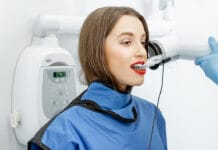1. Vital signs that should be taken at each appointment include(s) which of the following?
Vital signs are taken at each appointment to establish a baseline for each patient as well as to identify possible undiagnosed medical conditions. Failure to complete this task equates to providing substandard care to patients. The importance of temperature checks became highlighted during the COVID-19 pandemic; though this was a new practice for many, it should have been standard care all along.
Standards for Clinical Dental Hygiene Practice. (2016). American Dental Hygienists' Association. Retrieved from https://www.adha.org/resources-docs/2016-Revised-Standards-for-Clinical-Dental-Hygiene-Practice.pdf
2. Full-mouth periodontal assessment should include probing depths, bleeding points, suppuration, recession, mucogingival defects, and attachment level. This information does not need to include a written description.
Full mouth periodontal charting includes documentation of the following data points: probing depths, bleeding points, suppuration, mucogingival relationship/defects, recession, and attachment level/attachment loss. This information should be reported by location, severity, quality and include a written description.
Standards for Clinical Dental Hygiene Practice. (2016). American Dental Hygienists' Association. Retrieved from https://www.adha.org/resources-docs/2016-Revised-Standards-for-Clinical-Dental-Hygiene-Practice.pdf
3. Risk assessment is done to design strategies tailored to everyone for preventing or limiting disease and promoting health.
Risk assessment should be done on every patient to better guide the clinician in designing a plan that supports the prevention of disease or limits the disease's progression. A properly designed strategy will promote oral and overall health. Risk assessment criteria include the following:
- Fluoride exposure
- Tobacco exposure
- Nutrition and dietary habits
- Systemic disease and/or conditions
- Prescription and over the counter medications
- Salivary function
- Age and gender
- Genetics and family history
- Habits and lifestyle behaviors (e.g., substance abuse, cultural practices, eating disorders, piercing/body modification, oral habits, sports, and recreation).
- Physical disabilities
- Psychological, cognitive, and social considerations
Standards for Clinical Dental Hygiene Practice. (2016). American Dental Hygienists' Association. Retrieved from https://www.adha.org/resources-docs/2016-Revised-Standards-for-Clinical-Dental-Hygiene-Practice.pdf
4. Identifying all needed dental hygiene interventions, including change management, preventive services, treatment, and referrals, is part of which dental hygiene standard?
During the planning phase of the dental hygiene standard of care, the dental hygienist incorporates all the following:
- Identify all needed dental hygiene interventions
- Collaborate with patients/caregivers to prioritize interventions
- Identify and coordinate resources
- Collaborate and work effectively with the dentist and other health care providers
- Present and document dental hygiene care plan
- Counsel and educate the patient/caregiver about treatment
- Obtain and document informed consent and/or informed refusal
Standards for Clinical Dental Hygiene Practice. (2016). American Dental Hygienists' Association. Retrieved from https://www.adha.org/resources-docs/2016-Revised-Standards-for-Clinical-Dental-Hygiene-Practice.pdf
5. During implementation, the dental hygienist should review and confirm the dental hygiene care plan with the patient/caregiver. However, it is not the dental hygienist's responsibility to monitor patient comfort during the implementation of the treatment.
During the implementation phase of the dental hygiene standard of care, the dental hygienist is responsible for the following:
- Review and confirm the dental hygiene care plan with the patient/caregiver
- Modify the plan as necessary and obtain additional consent
- Implement the plan beginning with the mutually agreed upon first prioritized intervention
- Monitor patient comfort
- Provide and necessary post-treatment instructions
- Implement the appropriate self-care intervention
- Confirm the plan for continuing care or maintenance
- Maintain patient privacy and confidentiality
- Follow-up as necessary with the patient
Standards for Clinical Dental Hygiene Practice. (2016). American Dental Hygienists' Association. Retrieved from https://www.adha.org/resources-docs/2016-Revised-Standards-for-Clinical-Dental-Hygiene-Practice.pdf
6. Dental hygiene records are considered legal documents and as such should include the complete and accurate recording of all collected data, treatment planned and provided, recommendations (both oral and written), referrals, prescriptions, patient/client comments and related communication, treatment outcomes and patient satisfaction, and other information relevant to patient care and treatment.
Documentation is a very important part of the dental hygiene standard of care. The goal of good documentation is to provide the patient with optimal care through communication within the practice and other practices if the patient needs to be referred to a specialist. Having proper documentation will enable all healthcare providers to maintain continuity of care with the knowledge of previous treatment and progression or stabilization of a disease process. The following are guidelines set by the American Dental Hygienists' Association regarding documentation:
- Document all components of the dental hygiene process of care
- Objectively record all information and interactions between the patient and practice
- Record legible, concise, and accurate information
- Recognize ethical and legal responsibilities of recordkeeping, including guidelines outlined in state regulations and statutes
- Ensure compliance with HIPAA
- Respect and protect the confidentiality of patient information
Standards for Clinical Dental Hygiene Practice. (2016). American Dental Hygienists' Association. Retrieved from https://www.adha.org/resources-docs/2016-Revised-Standards-for-Clinical-Dental-Hygiene-Practice.pdf
7. Dental hygienists work in partnership with all members of the dental team. Dentists and dental hygienists practice together as colleagues, each offering professional expertise for the goal of providing optimum oral health care to the public.
"Dental hygienists work in partnership with all members of the dental team. Dentists and dental hygienists practice together as colleagues, each offering professional expertise for the goal of providing optimum oral health care to the public." Dentistry is a team sport; every team member brings a certain level of expertise. By collaborating and sharing our expertise, we can better serve our patients and provide optimal care. Dental hygienists should strive to elevate their level of expertise through continuing education courses as well as learning from fellow dental hygienists and dentists that they meet along their journey in dentistry.
The distinct expertise of the dental hygienists and the dentists, when respected, compliment the effectiveness of each professional. With proper collaboration, this type of working environment will be fulfilling to the professionals and provide the highest level of care to the public.
Standards for Clinical Dental Hygiene Practice. (2016). American Dental Hygienists' Association. Retrieved from https://www.adha.org/resources-docs/2016-Revised-Standards-for-Clinical-Dental-Hygiene-Practice.pdf








